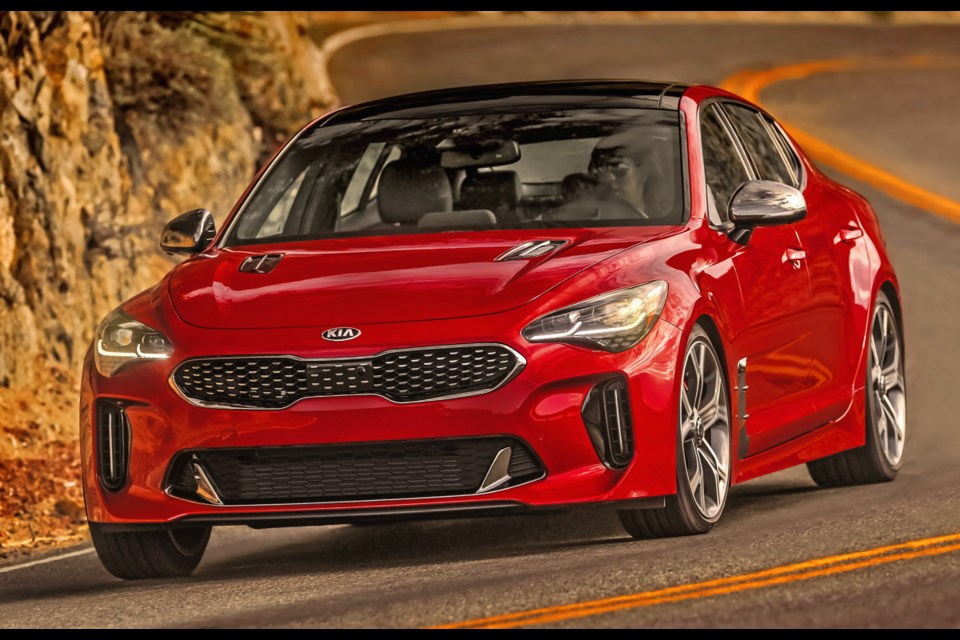The introduction of the 2018 Kia Stinger has been a game-changer for the sports/luxury car segment.
The thought of Kia, a brand more synonymous with practical economy cars, building a premium vehicle would have been unheard-of before the Stinger.
That it can produce a luxury performance car that can keep up with — and surpass — vehicles from Mercedes-Benz, BMW and others is jaw-dropping.
And yet here it is, a vehicle with ample power, sharp handling and one that looks the part to boot.
There are only two trim models in the line. I drove a 2018 Kia Stinger GT, with a list price of $44,195. There is also a GT Limited, which adds a number of creature comforts and technological aids, with a $49,995 list price.
Both cars come with the same powerplant, a direct-injection twin-turbo 3.3-litre V-6 that produces 365 horsepower and 376 foot-pounds of torque, available as low as 1,300 rpm. (Kia has added a turbocharged 2.0-litre four for 2019.)
The Stinger is electronically limited to a top speed of 269 km/h. Added up, these are numbers that warm the hearts of enthusiasts.
Give the accelerator pedal a firm push and you will be rewarded with a satisfying growl and a firm push to the back of the sculptured sport seats.
Kia claims a zero-to-100 km/h time of 5.1 seconds when you use its included launch-control program. Launch control? In a Kia? 5.1 seconds?
Consider that it is only 0.2 seconds slower than the BMW 340i xDrive. While the BMW wins this comparison, it is also north of $56,000.
And there lies the greatest strength of the Stinger — it’s not just its performance, but its value that shines.
Kia has come down this road before, as its early cars battled the Japanese brands for domination of the lower end of the economy-car market.
I had the opportunity to take the Stinger on the track as well, and this was where its straight-line speed advantage wore away.
The BMW, with its decades of refining, shone brighter in the handling department. The Stinger was good to a point, but as the speeds picked up I didn’t get the same confidence at the car’s limits.
But that is all moot when driving at regular highway speeds — where most of the owners of Stingers will be travelling. It is also entertaining to dive into the corners on road and track.
Part of its secret is its standard all-wheel drive and torque-vectoring control, where power is adjusted side to side as well as front and rear.
Throw in a set of staggered low-profile high-performance Michelin Pilot Sport 4 tires (225/40 R19 front, 255/35 R19 rears) and variable-ratio steering and you can spend an afternoon canyon carving with glee.
The four drive modes control the adaptive suspension, gearbox response and engine timing.
The eight-speed sift-by-wire automatic is responsive and there are steering-wheel paddle shifters.
Rounding off the equipment package are genuine Brembo brakes — 13.8-inch rotors in the front and 13.4-inch units in the rear.
Beauty is in the eye of the beholder, and it’s up to you to judge the Stinger’s lines. Suffice to say that Peter Schreyer’s influence in its bold and distinctive look is unmistakable.
If there is one criticism of the design, it would be that the high boot and steep contour to the rear compromises rearward visibility.
The cabin is a both businesslike and welcoming.
The interior designers kept controls, buttons and dials to a minimum, eschewing luxury cues in favour of a more driver-centric design.
The biggest surprise for most people is the rear liftgate - that’s right, the Stinger is a four-door hatchback (it’s powered as well) with all the advantages of that body style.
Cargo capacity is an impressive 660 litres with the back seats upright and 1,158 with both of the 60/40 split rear seatbacks folded.
My tester had a blind-spot detection system, rear parking sensors and rear cross-traffic alert. The Limited model adds a 360-degree camera system, autonomous emergency-braking driver alert system and lane-keep assist.
With its attractive design, even more attractive pricing and sparkling performance, the Kia Stinger is the outlier in the luxury performance segment.
Unlike other manufacturers, Kia has chosen not to spin off a luxury marque around the vehicle, making the Stinger the halo car of the brand.
If owning a luxury brand is important to you and your social standing, the Stinger is not for you. If you, on the other hand, believe in climbing the social ladder through talent, good looks or just plain grit, you will recognize the Stinger as a kindred spirit.
THE SPEC SHEET
Type: Compact performance car, front engine, all-wheel-drive
Engine: Twin-turbocharged 3.3-litre V-6, 365 hp at 6,000 r.p.m., 376 lb.-ft. of torque at 1,300 to 4,500 r.p.m.
Transmission: Eight-speed automatic with steering-wheel paddle shifters
Dimensions (mm): Length, 4,830; width, 1,870; height, 1,400; wheelbase, 2,905
Curb weight (kg): 1,873
Price (base/as tested): $44,195/$46,080 (includes $1,785 freight and PDI and $100 AC tax)
Options: Nil
Tires: 225/40 R 19 front 255/35 R19 rear on alloy wheels
Fuel type: Premium
Fuel economy (L/100km): 13.6 city/ 9.6 highway
Warranty: Five years/100,000 km new car, five years/100,000 km powertrain and five years/unlimited km roadside assistance



